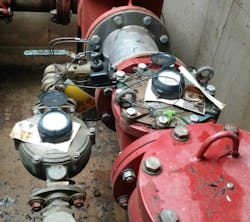Ultrasonic Upgrade
About the author: Kali Gerhardt is marketing manager for Kamstrup. Gerhardt can be reached at [email protected].
Technolgy advancements are rapid and never stand still. To purchase an iPad in the year 2000 (if it had existed then) would have cost $10,000 in today’s dollars. Now, we can purchase that product for $600. That is because technological advancements have come quickly while production costs have decreased. We are in the beginning of another major technology shift that will have global effects: the Internet of Things (IoT).
Products connected to IoT are connected to the internet and therefore can be controlled or operated remotely. By 2020, 8 billion devices will be IoT-connected, and by 2030, experts predict 1 trillion devices will be connected to IoT. To put this rapid growth rate into perspective, think of connected devices as seconds: 1 million seconds equals roughly 12 days; 1 billion seconds equals approximately 32 years; and 1 trillion seconds is 31,709 years. It is clear that the technology boom we have witnessed until now is just the tip of the iceberg. Automated meters are a section of that iceberg.
The U.S. is expected to be the largest market for automated metering infrastructure (AMI) between 2015 and 2025, according to the IHS Markit Water Market Report 2017. AMI meters are two-way communication water meters connected to a fixed network that utilizes the internet, cellular networks, radio frequency communication or a combination thereof to communicate meter data to the utility and vice versa. With this technology, meter reading takes place at the utility office instead of sending meter readers into the field. For utility workers, this is a major safety improvement; meter readers encounter unique and oftentimes unsafe situations, such as neighborhood dogs or walking on treacherous terrain and risking injury from falling and tripping hazards.
Accuracy Through Automation
In addition to the physical meter reading being improved, the measuring technology for most AMI meters has improved as well. Many of the AMI meters coming out today use static measuring technology. Both ultrasonic meters and electromagnetic meters are considered static meters, which are characterized by no moving parts, high accuracy, reduced pressure loss and no maintenance. The importance of meter accuracy cannot be overstated. Bertis M. McCarty, water circuit rider for the West Virginia Rural Water Assn. explained how the accuracy of water meters counts in the summer 2012 issue of WVRWA’s Mountain State Water Line magazine.
“Reading meters needs to be as accurate as possible and is one of the most important jobs for any utility. The whole cycle of a water utility evolves around the meter reading. New technology meters can make the difference to any struggling water system. The new meter systems will help warn the meter reader of possible leaks who, in turn, can warn the customers in a timely manner,” McCarty said. “Purchasing new meters instead of hiring the much-needed personnel to perform maintenance [such as a flushing program, a water audit program, a fire hydrant maintenance program or a valve exercising program] can be beneficial in many ways. The money savings compared to more personnel can be calculated easily. Shop around, talk to your peers, weigh in all the benefits and remember that cheaper is not always better.”
McCarty also warned readers about utilities being caught up in new technology. Citing two personal cases in which the register and the radio read were not matched up to the meters, he said not to be over-reliant on technology. A “trust but verify” approach to new technology is a strategic way to introduce it to the distribution system. Advancements in meters, however, have addressed these issues. With Kamstrup’s ultrasonic AMI meter, for example, the register and the radio are both inside the water meter, eliminating the error of misaligned registers and radios.
The Eastern Band of Cherokee Indians Water & Sewer Department installed ultrasonic water meters throughout its system. For every 20 meters installed, the department found one meter missing from its network. Adding them to the system further reduced non-revenue water.
Reducing Water Loss
Water professionals continually put forth their best efforts to reduce water loss; water is a precious resource worthy of conserving. The water balance framework created by the International Water Assn. divides water loss into two categories: real losses and apparent losses. Real loss in your water system is physical water that leaks from the water supply network. Apparent losses, on the other hand, are often referred to as “paper losses”, because no water is leaving the system, but the water is not being measured, is billed inaccurately or is consumed without authorization.
The Eastern Band of the Cherokee Indians (EBCI) Water & Sewer Department in Cherokee, N.C., faced such a water loss issue. After an EPA survey that showed the utility had 48% water loss in its system, it knew its old positive displacement meters were part of the problem. As reported in Cherokee’s local newspaper, Cherokee One Feather, Field Technician Supervisor Ethan Arch of EBCI describes how “a typical water meter loses 10% or more of its accuracy in the first 10 years. As time goes by, the inaccuracies worsen by 40% or more.” Some of EBCI’s older meters were up to 25 years old and did not register at all. In those cases, an estimated reading was generated.
“This is not fair to the customer nor to the utility,” Arch said.
EBCI started a meter change-out program to address the failing meters and large water loss.
“We wanted something new, a top-of-the-line solution for our water system,” Arch said. In searching for a metering solution, the utility’s head engineer attended the first-ever North American Water Loss Conference in December 2016. It was there that the engineer learned about ultrasonic measurement.
Arch said he had heard of ultrasonic meters before, but the general consensus was not good. When EBCI delved into the details of the Kamstrup ultrasonic water meter, however, opinions started to change.
“When hearing about the features of the meter, like its high accuracy and ability to maintain that accuracy over time, it sounded too good to be true,” Arch said. “Everything about the meter and the meter reading system was out of the norm. And we liked that.”
In addition to purchasing Kamstrup water meters, Arch and several other utility personnel visited the Kamstrup headquarters in Denmark to get to know the meter manufacturer better. As local journalist Scott McKie B.P. from Cherokee One Feather reported, the Cherokee team viewed the entire behind-the-scenes process of how Kamstrup meters are manufactured.
“While viewing the factory, the Water & Sewer staff watched water meters being made from the ground up. Once the process starts, robots are used to construct each meter. Kamstrup takes pictures and records every step of the build for each water meter. They store it so if you have a problem with a meter, they can go back and see at what step it failed, but they try to catch it before it gets to that point. It’s very rare that we get one that fails,” Arch said. “Once that process starts, [the meters] don’t touch human hands until they are taken out to be installed. So, they’re sanitized and everything.”
The ability for advanced meter technology to be flexible with changes is also an important aspect of selecting the right meter.
“Kamstrup has their stuff together. The way they think about designing products is with the next 20 years in mind,” Arch said. He also commented on how the country of Denmark was friendly and that the country’s forward-thinking mentality and philosophy bled into the products they make.
As an example, Arch explained technology changes so rapidly that keeping up with advancements can be challenging. Kamstrup meters, he said, are designed to keep up with technology. The computer chip inside the meter enables the utility to receive software and firmware updates, ensuring the meter evolves alongside new technology developments. Furthermore, upgrades to the meter reading system are possible with this meter. EBCI reads meters with Kamstrup’s smartphone-based drive-by meter reading system, but the utility has plans to migrate to AMI in the near future, especially since it will not require a new set of meters.
Having installed nearly all 2,400 connections, Arch said the equipment already has shown benefits. While the final water loss percentage has yet to be calculated, Arch said the utility is earning more revenue with the new meters. Also, he commented on how the meter installation process uncovered missing meters.
“For every 20 meters we replaced, we found one meter that was not in our system,” Arch said. Ensuring all meters are in the system and read further reduced non-revenue water.
The growth of technology, both within the water industry and outside of it, is inevitable. As the past shows us, technological speed is increasing while costs of technology are decreasing. The same is true for AMI water meters. Growth projections show more devices will connect to the internet. For water professionals, embracing new technology can improve the safety of working conditions and the accuracy of meter reading.

